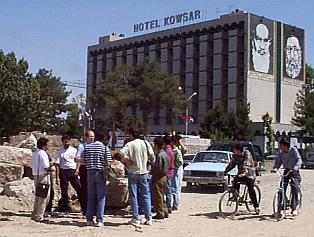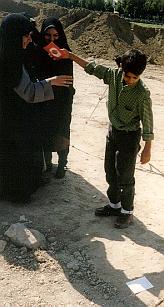This document amounts to a “memo to file” regarding the photography
I did during the eclipse and lessons learned therefrom. It is not
remotely intended as an authoritative source for eclipse
photography, details of which are given in almost any
astrophotography reference.
- Pace yourself to damp vibration.
- Remember that you're using a long lens to image
the Sun at a reasonable size on the image plane
and that consequently any vibration of the camera
can destroy all but the shortest exposures. Use
the sturdiest tripod you can manage, and be sure to
allow time after each film advance and change in
shutter speed to allow induced vibrations to damp
out before releasing the shutter with the cable
release. Be sure that when you make the exposure
you are connected to the camera only by a limp
cable release.
- Consider locking up the mirror.
- To further reduce vibration, consider locking up the
reflex viewfinder mirror before commencing your
series of exposures. But if you do so, make sure
(and practice enough times so you are sure)
doing so doesn't disturb camera aim or focus.
If you do lock up the mirror, be sure to cap the lens
or avert the camera from the direction of the Sun
at the moment totality ends, as the uneclipsed Sun
will then be focused on the focal plane shutter of
your camera, where it is likely to cause all kinds
of damage ranging from fogging your images of totality
to setting your camera and the film therein on fire.
This is bad; make sure it doesn't happen to you.
- Motor drive?
- Using a camera with a fast motor drive will undoubtedly
permit you to get off more shots during totality, but
if you opt for that be sure the drive doesn't induce
vibrations which wreck the sharpness of your images. Again,
a sturdy tripod will help. If you use a motor drive or
camera which requires battery power to function, install
fresh batteries before the eclipse and verify they
are working properly.
- Autofocus? Out of focus!
- If you use a camera with autofocus, be absolutely certain
it's disabled before you begin your eclipse shots and that
the lens is fixed-focused on infinity (which, for optical
purposes, is where the eclipse is occurring). You'll
probably want to make a quick check of camera aim and
fine focusing a moment after totality begins. Don't
look into the viewfinder before the start of totality;
you will probably blind yourself, which will degrade your
eclipse experience. Totality is a fuzzy-wuzzy target which
may cause autofocus cameras designed for more common
scenes to “hunt” in focus, reducing the number of shots
you're able to make, resulting in out of focus exposures,
or in the worst case leaving you with no pictures at all
if the camera refuses to release the shutter when it doesn't
think the lens is in focus.
- Don't cook your camcorder.
- The video Totality: The Movie
was made with a Sony digital video camcorder certified
by its manufacturer as safe to point at the Sun as long as
only its built-in lens was used. I took advantage of this
to aim the camera at the Sun a minute or so before totality
and leave it unattended for the duration. Don't assume
your camcorder will tolerate the uneclipsed Sun! Earlier
camcorders may incinerate their CCD sensors if aimed at the
Sun. Unless your eclipse budget includes unlimited funds,
it's best to resolve this issue by consulting the manual for
your camcorder or its vendor's support desk rather than by
experiment.
Remember Apollo 12.
Also note that while it's safe to aim a
camcorder at the Sun while looking at its video monitor screen,
it is not safe to aim at the Sun with an optical
viewfinder, as found on older camcorders and many present-day
digital still cameras.
- Watch out for the end of totality.
- Don't become so engrossed in totality you fail to notice
when it ends and the brilliant photosphere of the Sun begins
to reappear. Remember than staring at any portion of the
non-eclipsed Sun can damage your eyesight, so when totality
ends, turn your gaze to the other wonders around you such
as the Moon's shadow departing at twice the speed of sound,
the subtle shadow bands on light surfaces (if you're one of
the lucky few to glimpse them—I'm not among them…yet),
the dramatic brightening of the sky, and the reaction
of birds and animals, among them those of your own species.
Be extra sure you aren't observing the Sun through
unfiltered optics when totality ends—damage to your eyes
in that case will be more rapid and severe than to the
unaided eye. Note that looking through the viewfinder of
a camera with a telephoto lens is equivalent to observing the
Sun with a telescope, and can cause comparable injury to the
eye outside of totality.
- Photographing partial phases.
- If you want to record the partial phases of the eclipse,
consider doing so after the end of totality. The moment
totality ends, you can slap a solar filter over your telephoto
lens and burn up (figuratively—literally if you forget the
filter) the rest of your totality film roll on very narrow
crescents. (I wouldn't do this myself, fearing fogging or other
damage to the precious totality images.) Or, rewind and remove
the totality roll, load a fresh one, and fire away during
emergence. With a certified full-aperture filter mounted
securely on your lens, it's safe to aim and focus through the
viewfinder. If your camera has such latter day gimmicks
as auto-exposure and -focus, they will probably work fine in
the partial phase of the eclipse. It's easier to shoot
the partial phases after rather than before totality because
as totality approaches you're on edge anticipating what you're
about to see and worrying that you may have forgotten something.
After the show, you'll be on far more of an even keel (after
all, what you're seeing is an instant replay, in reverse, of
the first half of the eclipse) and find it easier to record
emergence. If your location permits it, be sure to shoot some
arty shots such as crescent Sun images projected through leaves
of trees.
- Bring a big lens, draw a big crowd.
-

 Unless you're viewing an eclipse in a remote area
solely in the company of other amateur astronomers,
setting up one or more cameras with large lenses
identifies you to more casual observers as an expert
on observing and photographing the eclipse. This is
wonderful; sharing one's love and knowledge of the sky with
others is among the greatest of the many rewards of
amateur astronomy. But if you've planned setting up your
photographic equipment and observing without distractions
and budgeted your time accordingly, the amount of time
you can spend answering questions and explaining things may
come as a surprise.
If you're planning to observe the eclipse in an area where
safe filters for viewing the partial phases aren't widely
available, consider packing a hundred or so to give
away—they're cheap compared to other expenses of an eclipse
expedition and they may help one or more children see a once
in a lifetime wonder and perhaps keep somebody from damaging
their eyesight. (Eclipse viewing filters were readily
available along the eclipse track in Iran, but a rumour had
apparently been reported on television that some of those on
sale were not safe, so the filters I brought from Europe were
much in demand and shared among those at the site I chose.
All of the Iranian filters I personally checked were perfectly
safe, but it's possible some were not.) Schoolchildren were
advised to view partiality with a pinhole camera as these
folks at left are doing (at the moment, the image of the
crescent Sun is missing the paper target, but he corrected
that a few seconds later). The local newspaper printed
instructions and a template for making one's own pinhole camera,
from which this one was made.
Unless you're viewing an eclipse in a remote area
solely in the company of other amateur astronomers,
setting up one or more cameras with large lenses
identifies you to more casual observers as an expert
on observing and photographing the eclipse. This is
wonderful; sharing one's love and knowledge of the sky with
others is among the greatest of the many rewards of
amateur astronomy. But if you've planned setting up your
photographic equipment and observing without distractions
and budgeted your time accordingly, the amount of time
you can spend answering questions and explaining things may
come as a surprise.
If you're planning to observe the eclipse in an area where
safe filters for viewing the partial phases aren't widely
available, consider packing a hundred or so to give
away—they're cheap compared to other expenses of an eclipse
expedition and they may help one or more children see a once
in a lifetime wonder and perhaps keep somebody from damaging
their eyesight. (Eclipse viewing filters were readily
available along the eclipse track in Iran, but a rumour had
apparently been reported on television that some of those on
sale were not safe, so the filters I brought from Europe were
much in demand and shared among those at the site I chose.
All of the Iranian filters I personally checked were perfectly
safe, but it's possible some were not.) Schoolchildren were
advised to view partiality with a pinhole camera as these
folks at left are doing (at the moment, the image of the
crescent Sun is missing the paper target, but he corrected
that a few seconds later). The local newspaper printed
instructions and a template for making one's own pinhole camera,
from which this one was made.
- Help, and enlist help.
- The flip side of drawing a crowd is that many people
will be willing to help with your photography during
the eclipse. This can be as simple as removing a
welder's filter from in front of a pre-positioned video
camera at the moment totality begins, permitting you to
image the final moments before second contact and all of
totality. I'd made my plans not counting on a crowd
and didn't bring the stuff they could have helped me
with, but if I'd had it there would have been no shortage
of volunteers to help. Of course, if you bring welder's
filters and the like, be willing to share them with others
who have shown up with video cameras without suitable
filters; everybody deserves a memory of the eclipse
they can share with others.
- Shoot the Moon.
- Recall that two weeks before any solar eclipse it will
always be full Moon regardless of where you are on
Earth. This can provide a perfect rehearsal of your
plans for totality as the Moon is almost the same size,
more or less,
as the Sun and has essentially the same apparent motion
for the duration of totality. Set up your equipment and count
down to a simulated start of totality, setting a timer
to go off at the end of the duration predicted for the
eclipse. Run through your complete photographic program
as many times as you like, and have the resulting
film processed to see how well you did. The experience
will increase your confidence when totality approaches, and
you may discover and remedy a problem in your experiments
with the Moon which might otherwise spoil your eclipse shots.
Since the full Moon doesn't go away like a total
solar eclipse, you can practice numerous eclipse runs
until you're sure you have your eclipse day routine down
pat.
by John Walker
August, 1999





 Unless you're viewing an eclipse in a remote area
solely in the company of other amateur astronomers,
setting up one or more cameras with large lenses
identifies you to more casual observers as an expert
on observing and photographing the eclipse. This is
wonderful; sharing one's love and knowledge of the sky with
others is among the greatest of the many rewards of
amateur astronomy. But if you've planned setting up your
photographic equipment and observing without distractions
and budgeted your time accordingly, the amount of time
you can spend answering questions and explaining things may
come as a surprise.
If you're planning to observe the eclipse in an area where
safe filters for viewing the partial phases aren't widely
available, consider packing a hundred or so to give
away—they're cheap compared to other expenses of an eclipse
expedition and they may help one or more children see a once
in a lifetime wonder and perhaps keep somebody from damaging
their eyesight. (Eclipse viewing filters were readily
available along the eclipse track in Iran, but a rumour had
apparently been reported on television that some of those on
sale were not safe, so the filters I brought from Europe were
much in demand and shared among those at the site I chose.
All of the Iranian filters I personally checked were perfectly
safe, but it's possible some were not.) Schoolchildren were
advised to view partiality with a pinhole camera as these
folks at left are doing (at the moment, the image of the
crescent Sun is missing the paper target, but he corrected
that a few seconds later). The local newspaper printed
instructions and a template for making one's own pinhole camera,
from which this one was made.
Unless you're viewing an eclipse in a remote area
solely in the company of other amateur astronomers,
setting up one or more cameras with large lenses
identifies you to more casual observers as an expert
on observing and photographing the eclipse. This is
wonderful; sharing one's love and knowledge of the sky with
others is among the greatest of the many rewards of
amateur astronomy. But if you've planned setting up your
photographic equipment and observing without distractions
and budgeted your time accordingly, the amount of time
you can spend answering questions and explaining things may
come as a surprise.
If you're planning to observe the eclipse in an area where
safe filters for viewing the partial phases aren't widely
available, consider packing a hundred or so to give
away—they're cheap compared to other expenses of an eclipse
expedition and they may help one or more children see a once
in a lifetime wonder and perhaps keep somebody from damaging
their eyesight. (Eclipse viewing filters were readily
available along the eclipse track in Iran, but a rumour had
apparently been reported on television that some of those on
sale were not safe, so the filters I brought from Europe were
much in demand and shared among those at the site I chose.
All of the Iranian filters I personally checked were perfectly
safe, but it's possible some were not.) Schoolchildren were
advised to view partiality with a pinhole camera as these
folks at left are doing (at the moment, the image of the
crescent Sun is missing the paper target, but he corrected
that a few seconds later). The local newspaper printed
instructions and a template for making one's own pinhole camera,
from which this one was made.